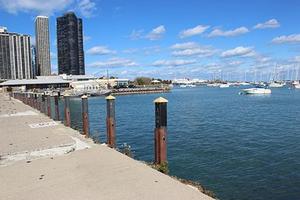Infrastructure protectionExploring ways to deal with Great Lakes water-level changes
Extreme water-level fluctuations in the Great Lakes, including historic lows on lakes Michigan and Huron in 2013 and substantial upward trends in 2014, are creating serious challenges for many shoreline property owners, tourism-related businesses, municipal planners, and others. To help these community decision makers determine the best strategies for dealing with these water-level changes, a two-tiered, two-year research initiative has been launched with the goal of developing information, tools, and partnerships to help decision makers address challenges and opportunities posed by water-level variability.

Great Lakes are in lower phase of their history of fluctuation // Source: northwestern.edu
Extreme water-level fluctuations in the Great Lakes, including historic lows on lakes Michigan and Huron in 2013 and substantial upward trends in 2014, are creating serious challenges for many shoreline property owners, tourism-related businesses, municipal planners, and others.
To help these community stakeholders and decision makers determine the best strategies for dealing with these water-level changes, the Graham Sustainability Institute is launching a two-tiered, two-year collaborative research initiative called the Great Lakes Water Levels Integrated Assessment.
A UMichigan release reports that the purpose of the assessment — a joint initiative between the Graham Institute’s Water Center and its Integrated Assessment Center — is to develop information, tools and partnerships to help decision makers address challenges and opportunities posed by water-level variability.
With a focus on lakes Michigan, Huron, and Erie, including the Lake Huron-to-Lake Erie corridor, the assessment will identify and evaluate environmentally, politically, socially and economically feasible adaptive actions and policy options.
“The question of what to do about changing lake levels is extremely complex,” said Integrated Assessment Center director John Callewaert. “There’s also contentious debate about engineering options and anticipated climate change impacts. Our assessment is focused on bringing relevant researchers and stakeholders together from both the United States and Canada to determine the most viable paths for moving forward.”
The first component of the assessment kicked off this month when the Graham Institute issued a Request for Proposals aimed at identifying appropriate localities and partners in the United States and Canada willing to collaborate. Up to ten teams will be selected to receive planning grants of up to $10,000 each for projects to run between March and August 2015.
Each project is to be led by at least two investigators affiliated with an academic institution. Selected projects will focus on identifying key geographies and issues impacted by water-level fluctuations, and analyzing viable policies and potential adaptive actions that would meet local objectives, as identified with community partners.
By pinpointing appropriate locations and scoping different approaches, these preliminary projects will lay the groundwork for the full, 18-month integrated assessment, through which four to five teams will receive funding of approximately $50,000 each.
The purpose of the final assessment, which will run from November 2015 to April 2017, is to help equip the region with a robust set of water-level adaptation strategies that protect the ecological integrity, economic stability and cultural values of each region.
“Water-level variability is impacting multiple areas, ranging from shoreline habitats to infrastructure, recreation and tourism, regional economies and more,” said Water Center Director Jennifer Read, a contributor to the International Joint Commission’s 2013 Upper Great Lakes Study, which will help inform the U-M assessment.
“While there has been extensive research about water levels, flows and impacts — including significant work by the IJC — this assessment is geared toward transforming findings into practical, localized strategies. Through such place-based, interdisciplinary partnerships, our hope is that the IA will facilitate the development of long-term solutions for each of the areas involved.”
The Graham Institute and Water Center are funding the water-levels assessment, with additional anticipated support from regional partners. The assessment is focusing on lakes Michigan, Huron and Erie exclusively, since specific regulatory frameworks are already in place for lakes Ontario and Superior.
